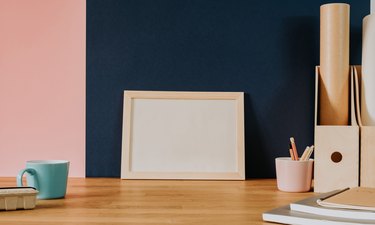
If you are attempting to update a photo frame only to find the picture stuck to glass, there are solutions. When photos get stuck together, you must proceed with caution; trying to separate them without knowledge or the right tools can damage the photos. Professional photo restoration services may be of help, but they can become prohibitively expensive in the case of older photos or extensive damage to the photograph. While professional restoration services are an excellent option, you can first take some steps at home to try and free the photo from the frame and glass.
Why Do Photos Stick to Glass?
Video of the Day
Generally, photographs stick to surfaces like glass, plastic and other photos because the gel used to capture and retain the images and colors of the photo has partially melted and re-bonded to whatever surface it's in contact with at the time. This process is known as "blocking" and is sometimes referred to as "ferrotyping." Ferrotyping is an older method of finishing developed photography. The photographic emulsion of chemicals was stored on a metal plate and polished by a hot metal drum to create a high gloss finish.
Video of the Day
Modern photographs can "block" when exposed to moisture for a prolonged period, which allows the emulsion to soften and weakens the bond to the paper backing. This process creates new bonds with the glass covering the photo or other surfaces in contact with the picture.
Prolonged exposure to heat can also create chemical reactions that partially melt the emulsion, resulting in the chemical bond transferring to another surface. Improper removal and separation techniques can further damage and distort photographs. Professional restorers will use their understanding of the chemical processes and materials involved to remove and restore these pictures to their original condition.
Removing a Picture Stuck to Glass
If you have a picture stuck to glass, it can likely be fixed. It's technically possible to perform this process yourself, but without training and knowledge, the chances of mistakes and accidental damage increase.
The first step in any blocking correction is to identify which picture areas have bonded with the glass. This identification is accomplished by edge-on illumination of the glass using a strip of LEDs or simply holding a flashlight at a low angle. Blocked areas of the glass appear lighter or green as the light reflects internally along the length of the glass, so target those areas as your focus.
Before beginning any recovery process, experts recommend taking a high-resolution scan or photograph of the picture to help with restoration and to be able to create a backup in case of damage to the original.
Breaking Chemical Bonds Between Photos and Other Materials
The first approach is to re-swell and soften the gelatin emulsion with water and water vapor, but this does risk the photo wrinkling and curling as it dries. A second approach is to separate the dry materials where they touch physically, but this bears the risk of scraping off or tearing the blocked portion of the picture. Option three separates the materials by exploiting temperature changes, but this method risks cracking or melting the emulsion.
An easy strategy for the first approach is by gently soaking the photo in distilled water, followed by careful and thorough blotting dry under weights positioned to minimize damage. The second method mentioned, pulling the dry photograph and the other material apart anywhere they are in contact, is not advisable, particularly for amateurs. This will nearly always result in damage to the photo. For the third method, gently apply heat from a hairdryer to the back of the photo or wrap the entire assembly in a towel and freeze it.
Remember, though, that these approaches are likely to result in a damaged or destroyed photograph without the proper training, materials and tools. However you decide to handle your blocked photographs, take your time and be careful. When in doubt, call a professional.